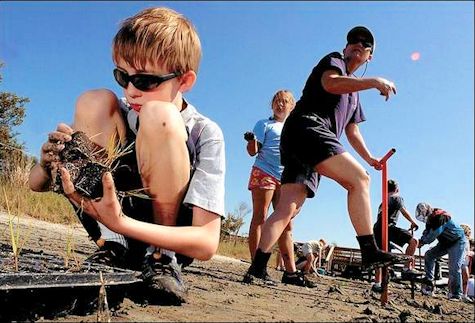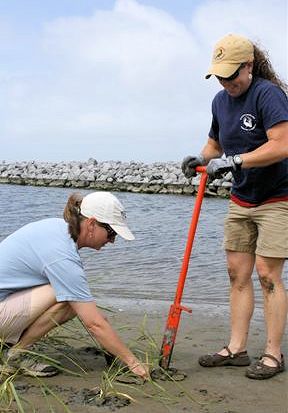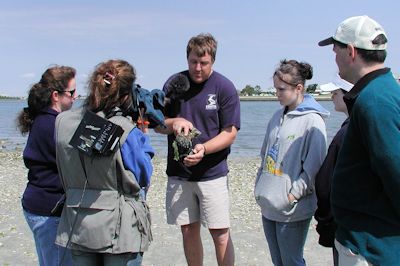Last of two parts
 The N.C. Coastal Federation offers a variety of educational programs throughout the year that get kids out of the classroom to plant marsh grasses and build oyster reefs and rain gardens. Photo: Wilmington Star-News |
Elizabeth Gray, a middle school science teacher at First Flight Middle School, is reading through comments her students have written about a recent field trip to Jockey’s Ridge State Park. Oysters, and the surprisingly important role they play in the ecosystem, are a common theme.
Supporter Spotlight
“Many [students] were surprised that they actually clean water,” said Gray.
After a day spent interacting at various learning stations, getting their hands wet and sandy, they likely won’t forget it. This is exactly why Sara Hallas, a coastal education coordinator with the N.C. Coastal Federation, led a horde of over 200 middle school students to the state park.
“Getting kids outside has always been a huge component of our approach,” said Hallas.
Recent research from N.C. State University, funded by N.C. Sea Grant, found that taking students outside improves many of the measures used to assess environmental literacy. Not only does going outside make students care more about the environment, but it also improves their ability to understand ecological processes.
The effects of taking students outdoors can be seen in an overall improvement in cognitive skills and academic performance. Hallas notes that many of the teachers she works with see the biggest change in students that typically have more difficulty learning in an indoor classroom.
Supporter Spotlight
“All of the teachers agreed that for the kids who have trouble in the classroom, such as they can’t sit still or don’t listen well, it [being outdoors] seemed to make a huge difference in terms of keeping them engaged in what they were learning,” said Gray.
 Sara Hallas, right, a federation educator, says many of the teachers she works with see the biggest improvements in students that typically have more difficulty learning in an indoor classroom. |
Taking the lesson from the classroom to the estuary, sound, or rain garden has long been the approach of the federation’s education outreach. And the federation wants to take outdoor education one step further and tie the education with restoration.
“A lot of what we try to do is go into schools and connect whatever we are doing, be it oyster restoration or rain gardens, to the field. We want to make the connection of knowledge in the classroom to doing some form of action in the field,” said Ted Wilgis, a federation educator along the southeast coast.
Oysters are one way the federation is bringing the ocean into the classroom and the students to the ocean. Combining in-classroom activities, such as oyster dissection, with field trips to the water to bag oysters and help build new reefs, helps to connect students with the reality of how the ecosystem actually operates. Because, let’s face it, it can be a whole lot more fun and engaging to put oysters in bags on the beach than to sit in a classroom and see pictures of reef restoration.
“Once kids see it, actually see the oyster reef, then they get it,” said Hallas.
Other outreach projects put students in the driver’s seat in making an effect on their local environment. A year-long wetland nursery project gives students along the northeast and central coast of North Carolina the opportunity to grow their own seedlings in a nursery at their school before transplanting them to the wetlands where they watch them grow and become a part of the ecosystem. Through long-term intensive projects such as these, the federation hopes to build a community of students who understand and care about their local environment.
As Hallas explains, “There becomes an extra component of becoming environmental stewards. That’s why we do the field projects at public sites, like Jockey’s Ridge, so they can come back and see how they [restoration areas] are doing. It gives them a piece of ownership.”
And for some students, these education experiences may be their only link to their state’s coastal environment. Gray notes that three of her students had never been to Jockey’s Ridge, even though the state park is only five minutes from their school.
Hallas has also seen a lack of experience with the environment in her work with N.C. students.
“The Coastal Fed started a partnership with Elizabeth City, which is about an hour from the coast, and found that most of the students have never been to the beach. We do classroom lessons, then take them out to the beach, and it is a big deal for them,” explained Hallas.
 Ted Wilgis, center, another federation educator, wants kids to know that they can have a positive effect on their environment. |
Wilgis stresses that, even for kids who do have a lot of environmental awareness and experience, it is important to strengthen the connection students have with their local environment.
“We focus on the coastal environment, but we also want students to become involved in their local environment. We try to connect kids with local issues – get them to know their local water bodies and make the connection between their ecological address and the impact their behavior can have on the their local environment. We really want them to know that they can have a positive impact on their environment,” explained Wilgis.
And it is not just students that the federation wants to reach. As a part of many of the federation’s outreach projects, such as the one at Jockey’s Ridge, teachers attend workshops that provide training and curricula on various environmental topics. The Restoration with Education program, a living shoreline project with a week-long workshop for teachers called Project Wetlands, is attended mostly by teachers from inland communities, providing a way for teachers to bring the coast back to their students. According to the research on environmental literacy, this is exactly what they should be doing. Teacher training and experience is the biggest predictor in improving environmental literacy in students.
All of the federation’s efforts seem to be making a difference. Hallas routinely hears reports from teachers that they can see a difference in their students. Not only do the students seem more engaged in the learning process, but their test scores are also better.
“I am convinced it is why our children do so well in the EOC (end of course) exams,” said Gray.
And as Sandy Ferguson, an eighth-grade science teacher at First Flight Middle School, said, “We all love the hydrosphere unit [the lesson plan that includes the field trip to Jockey’s Ridge]… can you guess why?”
It seems that bringing a bit of the classroom to coastal North Carolina is a win-win for students, teachers and the environment.







